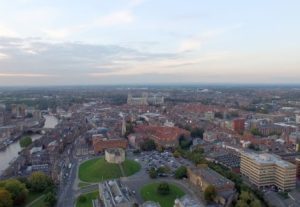Forecast says economic growth in Leeds will outpace rest of Yorkshire and Humber

Leeds is forecast to see its economic growth outpace the rest of Yorkshire & the Humber over 2024-2027, while the city is also expected to keep pace with the national rate of growth over the same period.
This is according to EY’s latest Regional Economic Forecast.
Although Yorkshire and the Humber as a region is expected to continue facing marked challenges, Leeds’ economy is expected to grow by 1.9% per year on average over the course of 2024 to 2027, when measured by Gross Value Added (GVA).
Yorkshire and the Humber is forecast to see annual average growth of 1.7% per year over the same period, while the UK overall is expected to see 1.9% growth.
Leeds is also projected to see employment grow by 1.2% per year between 2024 and 2027, outpacing both the UK (1.1%) and regional (1%) averages.
By 2027, GVA in Leeds’ local economy is expected to be more than £1.8bn larger than in 2023.
Meanwhile, Doncaster, Wakefield and West Yorkshire Combined Authority are expected to have the joint-second fastest-growing economies across the region from 2024 to 2027, with each projected to see annual average GVA growth of 1.8% over the period.
West Yorkshire Combined Authority is expected to see 1.1% annual growth in employment, in line with the national rate, while Doncaster’s (1%) and Wakefield’s (1%) annual employment growth rates are expected to keep pace with the average across the Yorkshire and the Humber region.
Stephen Church, EY’s North Market Leader, said: “It is important locations across the North use their unique strengths to drive growth.
“There are still a significant number of places in the North expected to trail quite considerably behind national and regional averages both in terms of GVA and employment, highlighting room for improvement.
“Going forward, it is critical that the public and private sectors collaborate to maximise opportunities.
“Leaders and businesses in the North should prioritise building skills and capabilities that will be in demand across high-growth sectors, while making the most of our region’s fundamental strengths such as our industrial prowess in the North East and Yorkshire, and our technology expertise in the North West.”
Yorkshire & the Humber’s forecast 2024-2027 growth highlights an expected recovery in the coming years, after the region’s economy saw an outright contraction of 0.1% in 2023.
The region’s manufacturing, wholesale and retail trade and real estate sectors are expected to remain the leading contributors to GVA in Yorkshire and the Humber between now and 2027, with the construction, information and communication, and human health and social work sectors also expected to see significant growth over the period.
Elsewhere in the region, York, Sheffield and Bradford are expected to keep pace with Yorkshire and the Humber’s annual average GVA growth (1.7%).
However, York and Sheffield are forecast to outpace the region’s employment growth, with each expected to see 1.1% growth per year from 2024-2027 – in line with the national rate.
Bradford is expected to see 1% employment growth per year, slightly trailing the national rate, but in line with the regional average.
Barnsley is also expected to see a combination of 1.7% annual average GVA growth, as well as 1% employment growth between 2024 and 2027.
Rotherham, North Yorkshire, Calderdale and Kirklees are all expected to see an annual average of 1.6% GVA growth over the period, marginally trailing the regional rate.
Calderdale and North Yorkshire are forecast to see 0.9% annual employment growth, narrowly trailing the regional rate, while Rotherham (0.7%) and Kirklees (0.8%) are expected to see slower annual average jobs growth rates.
Hull is expected to see the region’s slowest economic growth from 2024-2027, with an annual average rate of 1.5%. The city is also expected to see the region’s joint-slowest employment growth rate (0.7%).








